The History & Salvage of the SS City of Vera Cruz
By underwater archeologist E. Lee Spence, all rights reserved
Lost approximately thirteen miles north east of Cape Canaveral, Florida, while carrying a large quantity of valuable jewelry, the SS City of Vera Cruz, wrecked in 1880, makes a tempting target to divers. Although some salvage was probably conducted in the late 1800’s, it is no way that the salvors got all of what she carried, and no one knows what treasures may still be hidden on the wreck. With the passage of a full century, her location, contents, and name became secrets known only to the the fish and the souls of the people who perished on her.
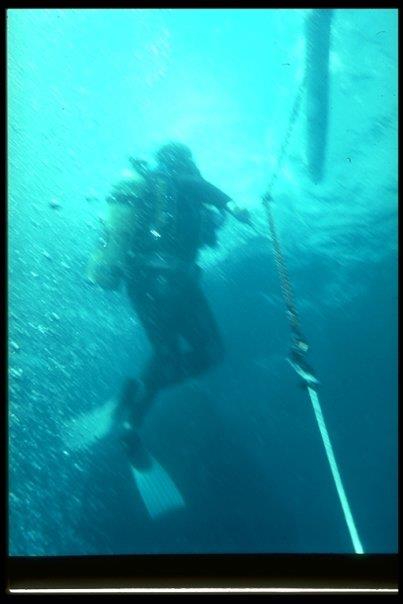
Diver surfaces from a dive on the wreck of the steamer City of Vera Cruz.
Photo by Kevin Rooney, © 1987 by E. Lee Spence
About 1980, Randy Lathrop, a professional treasure hunter and underwater cinematographer, learned of the wreck through fishermen, who had accidentally come across and fished it, but didn’t know what it was. Because we were old friends, and he trusted me from past ventures, Randy called me for help. Within an hour, based solely on the information Randy was able to provide over the phone, I was able to correctly identify the steamer from data I already had in my private archives. We promised each other equal shares in whatever project either one of us put together on the wreck.
It took a lot of effort, but I finally put together a project with the backing of a, then brand new, salvage company, I had helped to start, but which I did not own or control. It was a Pennsylvania corporation called Shipwrecks Inc. and was named after the first company I had started in South Carolina many years before. The company’s initial operations on the wreck were directed by myself, as underwater archeologist and project director. Ownership of the wreck was awarded to Shipwrecks Inc. by the Federal District Court in Orlando, Florida, after an admiralty suit was brought against the wreck in 1984. Our original verbal agreement was finally reduced to writing and Randy Lathrop and I each own five percent of anything Shipwrecks Inc. takes off the wreck (although the company has yet to give either one of us a single artifact as part of our share).
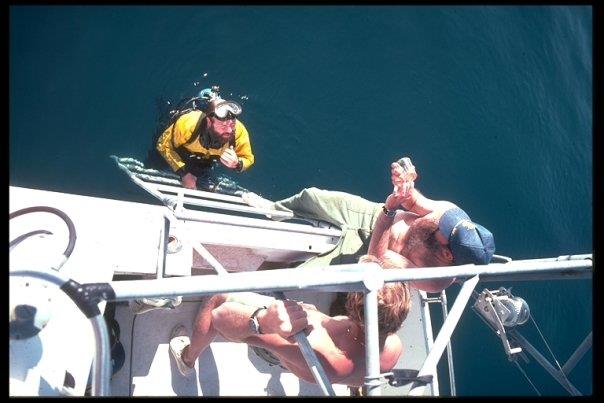
Dr. E. Lee Spence stands on the dive ladder of the RV Slo Motion,
while Captain Steve Howard examines glass tumbler found on the wreck.
Photo by Kevin Rooney, © 1987 by E Lee Spence
The City of Vera Cruz’s giant steam engine towers thirty feet off the bottom attracting thousands of colorful fish. Her huge twin boilers, twelve feet in diameter, still sit upright like enormous rusted cans. Visibility on the wreck, which is highly unpredictable, varies from mere inches to as much as fifty feet in the winter months. At least twice, boats anchoring over the wreck have had their anchors fouled by majestic manta rays, and have been towed off the site. In the winter months several jewfish, weighing in the hundreds of pounds, make the wreck their home. These giant creatures, like the sharks and sea turtles that frequent the wreck, appear to be her guardians. Shipwrecks Inc., recognizes the public’s interest in the beauty and history of this wreck, and has made no attempt to curtail sport divers’ or fishermen’s access to the site.
She was a brigantine rigged, steam ship of 1,874 tons register, built at John Englis’s shipyard at Greenpoint, Long Island, New York, in 1875. The vessel was two hundred and ninety-six feet in length, thirty-seven feet in breadth, and had three decks. She was intended, and used exclusively, for the lucrative passenger and freight trade between New York City and Vera Cruz, Mexico. The steamer made regular stops at Havana, Cuba. Her giant propeller was fifteen feet six inches in diameter and had a pitch of twenty-three feet. The City of Vera Cruz’s wooden hull was strengthened by heavy iron strips, four inches wide and over a half inch thick. She had accommodations for one hundred passengers, the cabins and state-rooms being handsomely equipped and furnished. At the time of her loss, the ship itself was valued at over $200,000. Based on the relative price for an ounce of gold, then just under $20.00 an ounce versus today’s (July 3, 2013) price of gold at $1,250 per ounce, that would be today’s equivalent of $12,500,000. The total value of her cargo was not reported. It is believed that she was partially insured by the Atlantic Mutual Insurance Companies of New York.
The steamer carried a miscellaneous cargo embracing more than one hundred varieties of goods. Besides the jewelry mentioned above, her cargo is known to have included cutlery, carbines, revolvers, pistols, toys, sewing machines, glassware, corsets, velocipedes (old time bicycles), wine beer, perfume, clocks, drugs, furniture, various food stuffs, machinery, railroad and street cars, and even an iron safe and a billiard table. The large iron wheels from the narrow gage railroad cars are now piled in a jumbled mass in the bow section of the wreck. Glass tumblers, which come in five sizes and look much like those in a modern bar, are frequently found in the shifting sands around the wreck. The iron safe mentioned in the manifest and the ones certainly carried by the ship’s captain and purser are not visible anywhere around the wreck. It’s possible that the safes were jettisoned in an effort to save the ship, or, more probable, they were salvaged along with the ship’s propeller shortly after the wreck took place. Needless to say, Shipwrecks Inc. is hoping (or should I say dreaming) that the safes weren’t salvaged and are merely be buried in the shifting sands on the site. But at this point, I don’t hold out much hope that the safes are still waiting to be found. I have already seen too much evidence that 19th century salvors found her and salvaged her. Despite that, I do believe that at least some of the private treasure remains.
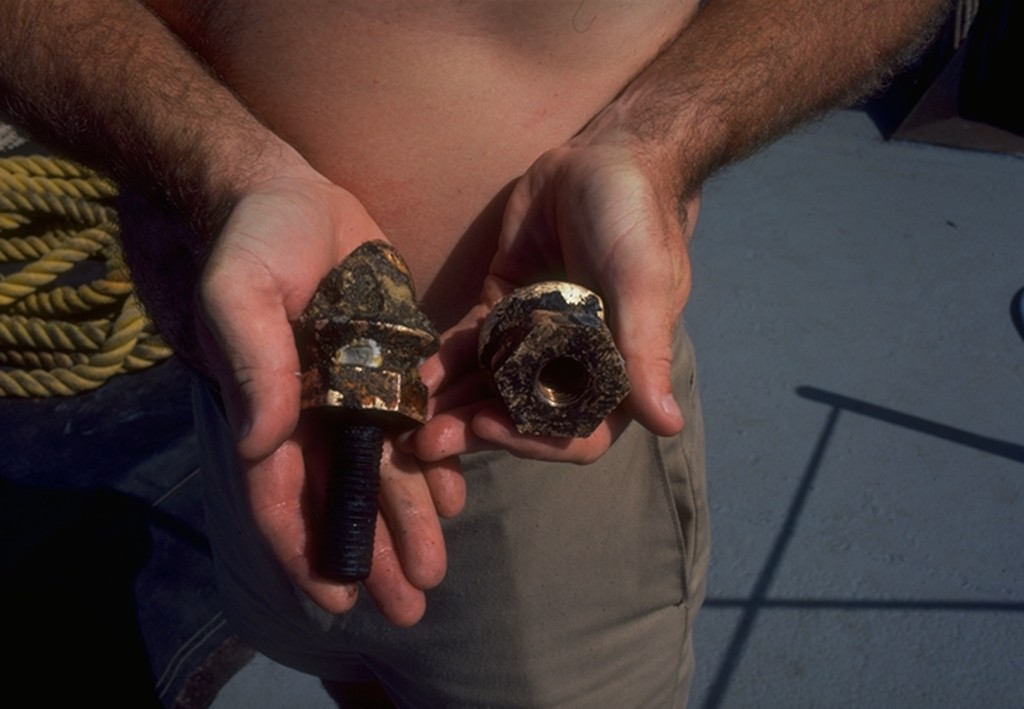
Large brass “acorn” nuts taken from the steam engine on the wreck of the City of Vera Cruz. Note that the brass threads in the nut turned with its bottom towards the camera. Although underwater for over one hundred years, the threads are still shiny.
Photo by Kevin Rooney, © 1987 by E. Lee Spence
One of the survivors lost five thousand dollars (face value) in gold coin on the wreck. Those coins would be worth a minimum of one hundred thousand dollars, and possibly as much as seven and half million dollars today. It is not known how much additional specie (coinage) was carried and lost by the other passengers, but, no doubt, it was a substantial amount. Remember these people were traveling to a foreign country where United States paper money and bank checks would have been little use to them. Odds are, those who were moving to Mexico to live, had liquidated homes and property, before the voyage and were carrying every single dime they owned with them. Depending on what remains, the antique or collector’s value of the City of Vera Cruz’s non perishable cargo (not counting the coins or the jewelry) could well run into the millions of dollars.
All we know about the jewelry is that it was owned by two very successful international jewelers, who perished in the wreck. And, that the jewelry was to have been used to open a new jewelry business in Mexico. For various reasons, it is safe to assume that the large quantity of valuable jewelry included many diamonds and emeralds. Some of them may have been quite large. Bill Glenn, president of Shipwrecks Inc. believes that the safes have yet to be salvaged and says that the value of the jewelry, on today’s jewelry collector’s market, would be in the tens of millions of dollars. Additional jewelry was probably owned by the other passengers. In fact, we know that tens of thousands of dollars in jewelry was recovered when trunks of clothes and personal items were washed ashore after the wreck.
On August 28, 1880, a terrible hurricane struck the City of Vera Cruz. One of the steamer’s lifeboats was loaded with people and readied for launching, but the boat was dashed to pieces before they even reached the water. Those who were not crushed to death outright were dropped, half stunned, into the sea, where they were drowned. A second boat met the same fate.
Men and Women were in the cabin praying and shrieking, and screaming. All of a sudden there was a snapping sound as of many timbers giving way. In the next minute the City of Vera Cruz went down, carrying all aboard. Then one person and another came to the top, grasping wildly for something to support them. The nearest land (Cape Canaveral, Florida) was almost thirteen miles away, and there was no way that the current was going to let them swim straight for it. The water was dotted with their heads and was filled with heavy pieces of wreck. Some of them were struck by this stuff, and so much stunned that they went down again, never to come up. Sixty nine men women and children perished.
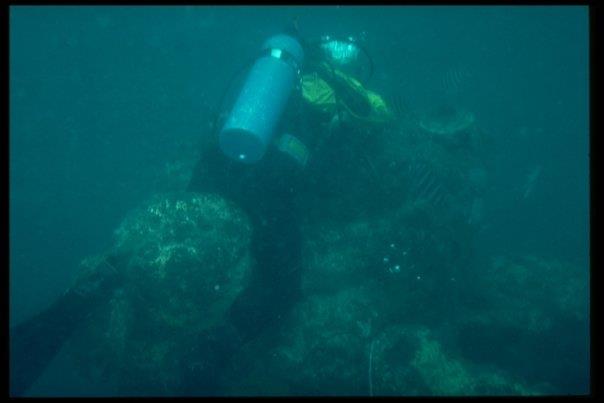
In an effort to work in the heavy current, Dr. Spence straddles part of the steam engine of the SS City of Vera Cruz.
Photo by Kevin Rooney, © 1987 by E. Lee Spence
Somehow, eleven men found the courage, strength and stamina to survive the mountainous seas and the foam which they sucked in with each tortured breath. Twenty six hours later the, by then, nude, battered and exhausted survivors struggled ashore about fifteen to twenty miles south of Daytona.
General Torbert, an old man with a white beard, who had once fought bravely in the Civil War, was among those who managed to make it to the beach alive. The fearless, but tender General had sought to calm the crying children before the ship sank, and he deserved to live. But, the General’s old body had been pushed to far, and he died at the water’s edge.
A mother, tightly clasping her daughter to her chest, was sighted shortly after the ship went down. A day later, over thirty miles from the wreck, still bound in the same embrace, they came ashore, but both were dead. Seaman James H. Kelly had saved the lives of others on four previous occasions, and it was now his turn to be saved. Kelly may have felt the hand of God on his shoulder as he stumbled ashore. But Kelly and the others who survived the tempest were to live with the nightmare of it for the rest of their lives.
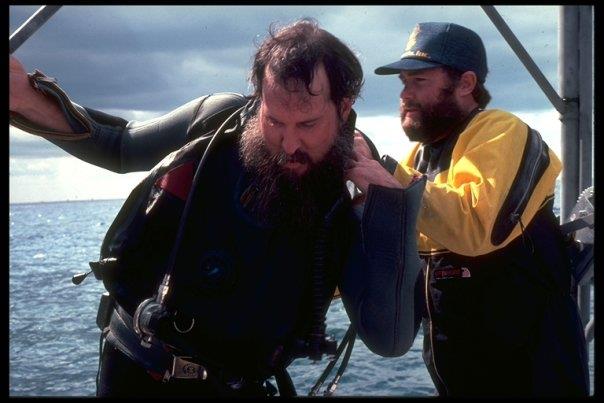
Spence in yellow drysuit assists boat captain Steve Howard with his dive gear.
Photo by Kevin Rooney, © 1987 by E. Lee Spence
The story of the valiant struggle of those who lived and those who died, causes the casual observer to regard the wreck as a watery mausoleum. It tempts one to run out and pass laws which would insure that the wreck, and what it holds, would remain undisturbed as a memorial. But, that would be wrong. Not only are the bodies long gone (most washed ashore within days after the wreck), but it would mean that we would all lose. The story of those unfortunate people would quickly be forgotten (as it was for a century) if the wreck was treated as a grave and left untouched, or worse, like most graves, unvisited. But, as divers explore the wreck, they feel its awesome past, and they are captured by its beauty. The divers, who remove artifacts, are not desecrating the wreck they are saving it.
The wreck is slowly dying of natural causes. Electrolysis, erosion, marine flora and fauna, and the force of the waves daily eat at the wreck, destroying and scattering parts of it. One day the wreck will be lost forever.
The glass tumblers, the brass valves, the bullets and the other trinkets recovered by sport and salvage divers allow them to share the story with their children and with non-diving friends. The crew and passengers of the City of Vera Cruz are brought back to life each time a person views or holds the small treasures that the divers have salvaged. The artifacts that are recovered, and the stories that go with them, are the most fitting memorials to the souls of the City of Vera Cruz’s dead. Each artifact becomes, in effect, a meaningful memorial, a testimony to the reality of the lives of those who sailed aboard the City of Vera Cruz.
To date, Shipwrecks Inc. has made three major efforts on the wreck of the City of Vera Cruz. Each of the projects has been successful in its own way.
The first effort was made out of Shipwrecks Inc.’s thirty-one foot dive boat, the Cut Out. That project consisted primarily of measuring and mapping the wreck site. All diving was done with SCUBA. The Cut Out was equipped with dive ladders, a davit with a one ton winch, and a combination hookah unit and six-inch water induction dredge from Keene Engineering. The work team consisted of Steve Howard (boat captain and diver); Russ Wonsock (first mate, diver, and electrician); Charles Davis (a computer whiz and diver); David Moore (an underwater archeologist who has worked extensively with Mel Fisher); and myself (E. Lee Spence, as underwater archeologist and project director). Both Steve Howard and Charles Davis are life long friends of mine who had worked with me on previous projects.
Bill Glenn came down and shot a video of the work on the wreck. Bill, then still a novice at wreck diving, came close to cashing it in when he ran out of air on the bottom and spent precious time trying to locate the surface line. Bill wasn’t able to tell me what was happening because he had apparently forgotten or never learned the correct signal for “out of air.” When I finally realized the seriousness of the situation, I took a breath and passed my regulator to Bill. I had assumed that Bill knew how to make a controlled emergency ascent to the surface. However, Bill, in a state of panic, swam upwards as fast as he could, while I struggled to slow us down. Too rapid an ascent could have blown out our lungs and caused an air embolism or a spontaneous pneumothorax. We could have both been killed. Exhaling all of the way up, I didn’t get my regulator back, or another breath, until we were on the surface. Bill was shaken, but otherwise, we were both alright.
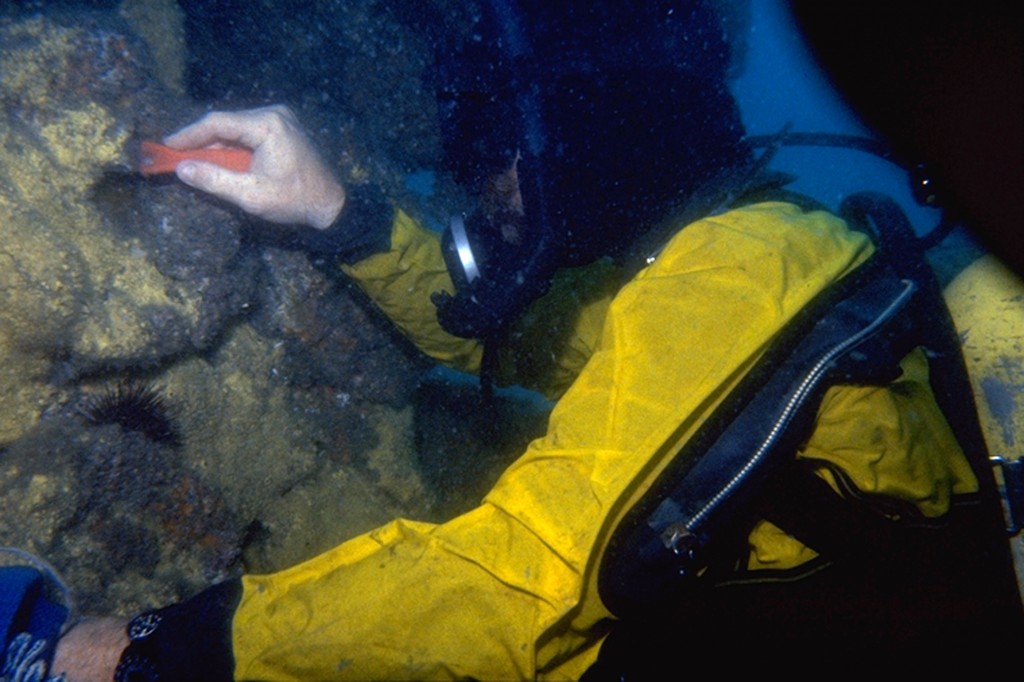
Spence removing one of the large brass gauges that he found still mounted on the steam engine of the SS City of Vera Cruz.
Photo by Kevin Rooney, © 1987 by E. Lee Spence
At one point Bill, against my advice, arranged for two men (both eye doctors) to come and check out the wreck site with a special device that they claimed would locate any precious metals hidden on the wreck. The men were two of the nicest guys I ever met, and definitely were both sincere and honest. But, when they described what they saw through their equipment, it still sounded like wishful thinking. They spoke of brightly colored auras emanating like volcanoes from the two piles of gold they believed were buried in the sand near the starboard side of the bow of the wreck. Although I was never allowed to examine their machine, I was convinced me that they were trying to find the treasure with some sort of fancy dousing equipment. Although, they selected two specific spots where their “readings” were strongest and several large holes were dug, only ship fittings and general cargo type artifacts were recovered. We called them both “Doctor Detector,” and enjoyed their company, but, in my opinion, they did nothing but waste everyone’s time and money, their’s included.
The next project was done as a joint venture with Salvage Masters Inc. Salvage Masters is headed by Jack Cover. Salvage Masters brought divers Marc Brakebill, Mike Woodard, Bob Hall, and Bryan Wynn. Jack and his entire team were professional divers who had worked extensively in the oil fields of the Gulf and the North Sea. Salvage Masters chartered Captain Bob O’Brien’s seventy-two foot salvage vessel, the Sea Jewel. Bob O’Brien is an excellent old time diver and salvor who regularly breaks the rules of diving and claims his various aches, pains, are merely arthritis or the gout. Cover’s men brought their own hard hat gear, hookah gear, dredges, and communications equipment.
Unfortunately, Bill Glenn had not believed my earlier evaluation of the two good doctors talents (or rather the lack thereof), and they had been allowed to return to make another try. The doctors had convinced Bill that we had simply not dug deep enough. The “readings” were completely inconsistent with those made the previous expedition. The new readings placed the “gold” on the port side near the stern of the wreck and were almost a hundred yards from where they had said the gold was the last time. I didn’t even want to check out the new spots. I felt their lack of consistency was sufficient proof not to waste any more time. But the decision was still made to go ahead and dig where the doctors said. What a waste of time and money.
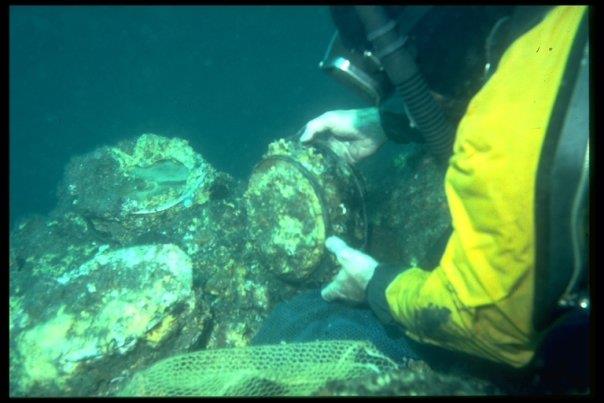
Dr. E. Lee Spence with 5 large brass gauges that he found still mounted on the SS City of Vera Cruz’s steam engine.
Photo by Kevin Rooney, © 1987 by E. Lee Spence
Salvage Masters did an excellent job of excavation, but no gold was located. The divers did recover quite a few pieces of the steamer’s cargo which got everyone excited. However, I believe that they could have recovered far more if the areas to dig had been selected through more traditional reasoning (based on science and archeology) rather than the method used.
I had to make a sudden, but controlled, emergency ascent around eighty feet of water when the hookah unit I was using was accidentally shut off by my tender who wasn’t paying attention to his job. My physical endurance, and my ability to avoid panic, was put to the maximum test during that ascent. The hookah hose had caught under a crossing dredge hose and I wasn’t aware of it until I was almost back to the surface. With not enough hose to reach safety, and fearing that I would be swept away from the salvage boat if I ditched the gear, I dove back down. I swam back under the dredge hose. Doing so, gave me the slack I needed and I once again headed for the surface. I had completely vented my lungs and was starting to black out as my head broke the surface. I was physically drained, but summoned enough energy to I signal my tender to pull me to the boat. I later figured, that from the time I first realized there was a problem to the moment I reached safety, at least three and a half minutes had passed. I wasn’t angry with my dive tender, I was just thankful to be alive.
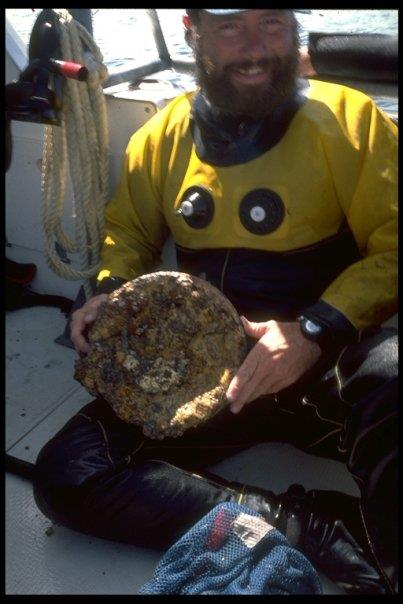
Dr. E. Lee Spence with brass gauge he found on the SS City of Vera Cruz.
Photo by Kevin Rooney, © 1987 by E. Lee Spence
The third project was done from Shipwrecks Inc.’s one hundred and sixteen foot salvage vessel, the Sea Raven. I had arranged the purchase and supervised the fitting out of the vessel and she was equipped with Diesel driven Ingersol Rand high and low pressure compressors, dredges, lifting gear, Klein side scan sonar (the same type as was used to locate the Andrea Doria), Fisher Laboratory metal detectors, lifting booms, stabilizers, etc. The Klein Hydroscan side scan sonar was used to search around the wreck for cargo which was jettisoned prior to the actual sinking of the steamer. The 1280-X Fisher Laboratory metal detectors were used to locate individual artifacts buried in the sand. This project was staffed with the same crew as the original project, except that Charles Davis was no longer with the team and David Moore had left to rejoin Mel Fisher on the Atocha. Also, eight new crew members had joined the team. The new members were Deborah Yankovic, Carter Glenn, Dave Wasick, Tony Camillieri, Al Martin, Al Savolskis, Mark Dyga and Kevin Rooney. As usual, everyone was fascinated by the ship’s history and loved diving on the wreck. Kevin Rooney’s hilarious antics and his superb diving skills made him my usual dive partner. As always, Captain Steve Howard’s easy going manner and sound judgement helped pull everyone together as a team. Tony Camillieri, who doesn’t understand how loud he snores, frequently found himself rudely awakened by thrown boots, etc. and was finally relegated to sleeping in the wheel house. However, Tony’s superb welding and diving skills were a valued asset to the team. Mark Dyga and Russ Wonsok proved their value time and again, not only as divers, but as electricians, when they wired and rewired equipment. Carter Glenn, seemed like a klutzy teenager, when he first came aboard, but quickly proved himself to be skillful, ambitious, hardworking and multi-talented. Carter took it on himself to become the ship’s expert at line and cable splicing. Like Kevin, Carter was a storehouse of off-color, but usually tasteful, humor, that served to delight the entire crew. Deborah Yankovic was hired for her emergency medical skills, but was also a good and dependable diver. Al Martin, Al Savolskis, and Dave Wassick, took turns at cooking and served as dive tenders and deck hands, unfortunately they couldn’t stay for the whole project and were sorely missed when they left. Many other projects have failed for the lack of such diverse talents, comradery and patience, among the crew. Many interesting artifacts were recovered, but once again the safes were not located.
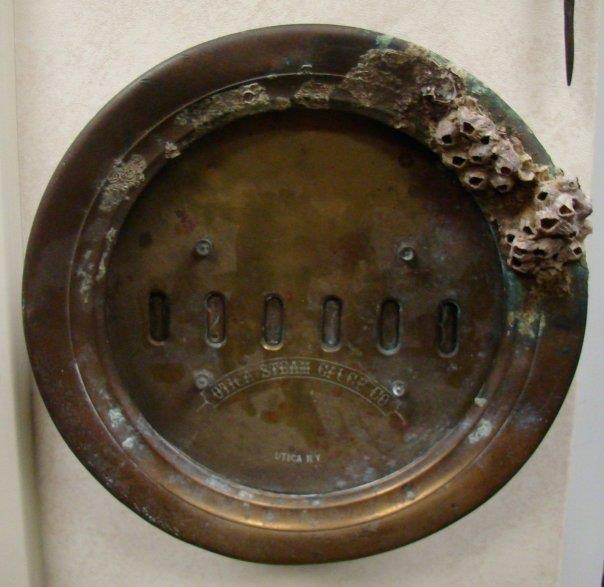
This partially cleaned gauge was one of five that I found on the SS City of Vera Cruz.
It recorded the numbers of revolutions turned by the ship’s giant propeller.
Photo by Spence © 2009 by E. Lee Spence
The wreck is a fairly easy dive, as the wooden hull has long since disintegrated and their are no compartments to penetrate. Most of the artifacts are scattered to the port side of the wreck. The giant propeller shaft still sits in its bearings. The propeller, was bronze or brass, and was probably salvaged shortly after the wreck took place. The center of the wreck is dominated by the ship’s boilers and engines. The main engine is mounted on a giant, structural iron, double A-frame. The main boilers are, in line, upright and just forward of the main water pump assembly, which is in turn just forward of the main engine. Two smaller, “donkey” boilers, which apparently had been mounted on the deck to operate the ship’s equipment, now lie in the forward area or bow of the wreck. A large windlass and capstan (which sits upside down and at an angle) also mark the bow. One large anchor has already been recovered, while a second anchor still remains a hundred feet forward of, and to the starboard side of the bow. Depths to the sand vary from seventy-two feet to seventy-six feet, but there are holes and washouts, and the dive should be planned as an eighty foot dive for safety.
Note: This article (© copyright 1989 by E. Lee Spence) was first published in Treasure Diver magazine, it has been slightly updated and the last paragraph containing contact information has been removed as it was no longer applicable.
The following comments were cloned from Facebook, where they had originally been posted in response to this article. You can add more comments below.
-
Lance MacNairn Very interesting read Lee.
-
Paul Whalen · Friends with Rob Stewart and 12 othersnicely written. Imagine it is a sweet dive. Sounds like a lot of cash was dropped on that gig.
-
Thomas Jalapeno Peltier wow, what a story
-
Gene Birdsong The individual stories of the people on, or involved with the shipwrecks are always as valuable as the cargoes…
Discussion
Add a Comment
-
Sea Research Society « Shipwrecks.com October 4, 2013
-
Shipwrecks.com July 3, 2013



